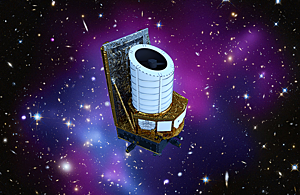
Euclid
Published By GOV.UK [English], Tue, Nov 24, 2020 10:05 AM
The Expanding Universe
Until 20-30 years ago, scientists thought that the Universe was composed of ordinary matter: protons, neutrons and electrons. Now we know that this accounts for only 4% of the Universe mass-energy budget. The rest is composed of two mysterious components, dark energy and dark matter, which are causing the expansion of the Universe to accelerate, and which cannot be adequately explained by our current knowledge of fundamental physics.
The UK Space Agency is funding research teams in 7 different institutions across the UK to contribute to the spacecraft. A team at University College London’s Mullard Space Science Laboratory is leading the development of one of the two science instruments on board, the visible imager (VIS), and researchers across the country are working to establish the complex data-processing capability to allow scientists to use the data that will eventually be sent back to Earth to study dark energy and dark matter.
Find out more from the ESA Mission Factsheet
What will do?
is a medium-class European Space Agency mission due to launch in 2022. Its objective is to better understand the nature of dark matter and dark energy by mapping the ‘Dark Universe’ and by accurately measuring the acceleration of the expansion of the Universe.
The spacecraft will have two scientific instruments on board that will use specialist techniques to answer key questions about our Universe.
What is the distribution of dark matter in the Universe?
What is the history of expansion of the Universe?
What does this tell us about the nature of dark energy?
How do large-scale structures form in the Universe?
What will the instruments be measuring?
The two techniques will be weak gravitational lensing and baryonic acoustic oscillation (BAOs). These will be used to measure galaxy shapes and distortions, telling us about the distribution and evolution of dark energy and dark matter.
Weak lensing will be used to measure distortions of galaxy images due to gravity. BAOs are wiggle patterns imprinted in the clustering of galaxies which act as a standard against which to measure the expansion of the Universe. Weak lensing in particular requires a visible imager which can achieve extremely high image quality – any optical distortion due to the instrument optical systems must be calibrated out so that any distortions which are measured will be due to gravity.
The scientific instruments
To study the nature of dark energy and dark matter, will carry two science instruments, each built by a consortium of European partners:
a visible imager (VIS) led by the UK at the Mullard Space Science Lab (MSSL)
a near infrared spectrometer and photometer (NISP, led by France)
The VIS Principal Investigator is Prof Mark Cropper at MSSL. The MSSL team has responsibility for managing the instrument consortium that has designed and built the various subsystems for VIS. MSSL is also directly responsible for the development of the detector chain of the instrument (the readout electronics receiving data from the sensors and their associated power supplies).
The Charge-coupled device (CCD) detectors are provided by Teledyne e2v in Chelmsford, under contract to ESA. The Flight Instrument was delivered to ESA for integration and testing in 2020 and will then begin being integrated with the spacecraft for the final environmental test campaign to confirm readiness for launch.
How is the UK involved?
During the 6-year mission the spacecraft will be bombarded by radiation in space, damaging the sensitive CCD detectors. To support the development at MSSL, the Open University has conducted modelling and simulations to understand how this radiation damage affects instrument performance. This will ensure that the science data can be interpreted accurately.
will generate an unprecedented volume of science data (850Gbit compressed data per day) and to cope with this, will employ K-band communications to provide the necessary rapid download rate.
In addition to the lead role on VIS, the UK also has a strong role on the development of the Ground Segment for . This includes a Science Data Centre in Edinburgh and the lead role on shear measurements and analysis, a critical element of science. Professor Andy Taylor of the Edinburgh Astronomy Technology Centre leads the development of the UK ground segment, with contributions from research teams at Oxford University, Cambridge University, University of Portsmouth, University College London, MSSL and Durham University.
Press release distributed by Media Pigeon on behalf of GOV.UK, on Nov 24, 2020. For more information subscribe and follow